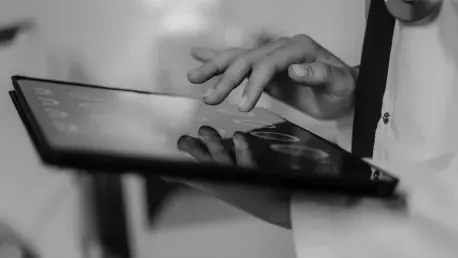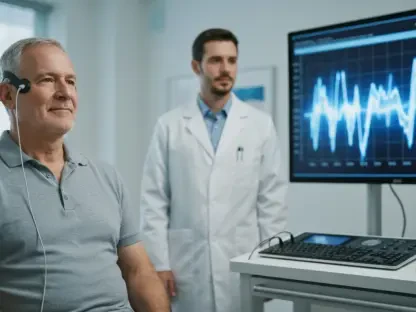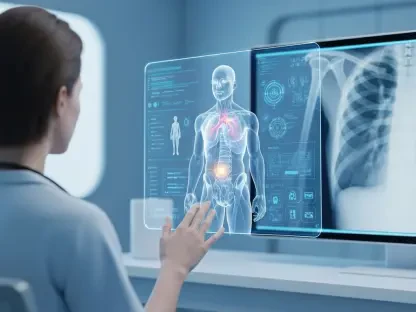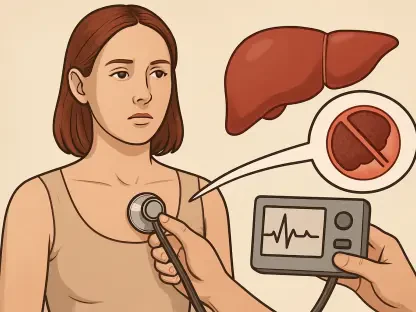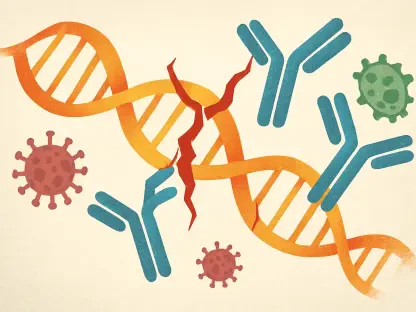In the realm of medical devices, nanotechnology has emerged as a revolutionary force, dramatically altering the landscape of healthcare through its advanced applications. By harnessing the power of nanoscale materials, this technology enhances diagnostics, therapeutics, and patient monitoring, ultimately reshaping conventional medical approaches. The global market for nanotechnology in medical devices is poised for remarkable growth, with its valuation projected to skyrocket from USD 4.7 billion in 2024 to USD 13.3 billion by 2035. This impressive ascent underscores the critical impact and rapid advancement spurred by innovative applications that promise to redefine patient care and medical interventions.
The Evolution of Nanotechnology in Medical Devices
Innovating Traditional Medical Technologies
The integration of nanotechnology into medical devices marks a significant shift from traditional technologies, offering groundbreaking improvements in functionality and biocompatibility. Engineered nanoscale materials, such as nanoparticles, nanofibers, and nanotubes, play a pivotal role across various domains, including drug delivery, diagnostic imaging, implantable devices, wound care, and surgical tools. These advancements, driven by precise engineering and material science, aim to tackle major healthcare challenges such as chronic diseases and the demand for minimally invasive procedures. By utilizing these innovations, patient outcomes can be dramatically improved while minimizing side effects.
The ability of these nanoscale devices to operate at a molecular level enables unprecedented precision in targeting specific cells or tissues, thereby enhancing the efficacy of treatments. For instance, in the drug delivery sphere, nanoparticles can ferry medication directly to diseased cells, reducing harmful side effects often associated with systemic drug distribution. Similarly, nanoscale imaging agents improve diagnostic capabilities by offering higher resolution images. As these applications continue to evolve, they hold the potential to revolutionize not only treatment modalities but also the entire healthcare delivery system by making it more efficient and patient-centric.
Addressing Chronic Diseases and Minimally Invasive Procedures
The prevalence of chronic diseases worldwide necessitates a strategic approach toward advanced medical interventions that are both efficient and less invasive. Nanotechnology’s integration into medical devices addresses this need by offering solutions that are tailored to meet the specific requirements of diverse medical conditions. For instance, technologies employing nanoparticles are designed to target cancer cells with high specificity while sparing healthy tissue, thus reducing the adverse effects typically associated with cancer treatments. This targeted approach is expected to significantly improve therapeutic outcomes and enhance patients’ quality of life.
Furthermore, the shift towards minimally invasive procedures is gaining traction as patients seek interventions that offer quicker recovery times and reduced procedural risks. Nanotechnology-enabled devices, such as smart implants and sophisticated surgical instruments, provide the precision needed for such interventions. These tools often feature intelligent sensors and control systems that allow for real-time monitoring and adjustments during surgical procedures, further enhancing their efficacy. As the demand for minimally invasive options rises, nanotechnology’s role in medical devices will likely expand, offering new possibilities for patient treatment and care.
Economic Growth and Market Dynamics
Market Growth and Investment Trends
The nanotechnology in medical devices sector is experiencing rapid expansion, characterized by a forecasted compound annual growth rate of 9.95%. This significant growth is fueled by substantial investments in research and development, driven by venture capital, corporate funding, and government initiatives. Interdisciplinary collaborations between academia, pharmaceutical companies, and technology startups are also crucial drivers, expediting the commercialization of cutting-edge nanomedicine. These partnerships leverage collective expertise, helping to overcome technical challenges and bring innovative solutions to market faster.
Targeted drug delivery systems, constituting the largest market segment, exemplify the efficacy and reduced side-effect profile that nanotechnology offers. As these systems continue to gain traction, they underscore the pivotal role of nanotechnology in enhancing medical interventions. Moreover, the burgeoning demand for personalized medicine solutions aligns with nanotechnology’s capabilities, as precisely engineered devices can be tailored to individual patient needs. This alignment further accelerates market growth, presenting opportunities for new entrants and established firms alike to capitalize on this transformative potential.
Navigating Regulatory Challenges
As the market for nanotechnology in medical devices expands, new regulatory frameworks are essential to address the unique characteristics and potential risks associated with nanoscale materials. The complexity of conducting comprehensive safety evaluations can result in prolonged approval timelines, averaging 18-24 months longer than those for conventional devices. Regulators must strike a balance between ensuring patient safety and fostering innovation by adapting existing guidelines to accommodate the intricacies of nanotechnology.
The current regulatory landscape poses both challenges and opportunities for stakeholders. On one hand, regulatory hurdles may deter some companies from entering the market. However, these challenges also incentivize the development of improved safety and efficacy standards, ultimately benefiting end users by ensuring high-quality and reliable products. Continued collaboration between industry and regulatory bodies is critical to refining approval processes, reducing bottlenecks, and enhancing the overall environment for nanotechnology-enabled medical devices.
Cultural Acceptance and Societal Impacts
Overcoming Consumer Apprehension
Despite its potential to transform healthcare, nanotechnology in medical devices faces hurdles in gaining widespread acceptance among consumers and healthcare providers. Public perception issues and cautious acceptance underline the need for comprehensive educational efforts to allay concerns over potential risks associated with nanomaterial exposure. Misconceptions about safety and ethical implications can lead to resistance, necessitating transparent communication and evidence-based outreach to build trust in this burgeoning field.
Engaging stakeholders through proactive educational campaigns, symposiums, and public forums can demystify nanotechnology and highlight its benefits clearly and convincingly. In particular, the healthcare community’s apprehension can be addressed by conducting and disseminating robust clinical trials and research that demonstrate the efficacy and safety of these technologies. As stakeholders become more informed about the tangible benefits of these innovations, acceptance is likely to grow, facilitating smoother integration into everyday medical practice.
Enhancing Public Engagement and Confidence
Building public confidence in nanotechnology’s role in healthcare requires a concerted effort to enhance understanding and transparency. This involves actively engaging patients, healthcare providers, and regulators through meaningful dialogues about the promising potential and challenges of nanotechnology. Establishing ethical guidelines and safety protocols that prioritize patient well-being is essential to cultivating trust and ensuring responsible deployment of these technologies.
Moreover, advocating for the establishment of standards and best practices across the industry can reassure stakeholders about the quality and consistency of nanotechnology-enhanced medical devices. As more success stories emerge and testimonials from patients and clinicians surface, the public’s appreciation for nanotechnology’s contributions to improved patient outcomes will likely increase. This shift in perception can bolster confidence and stimulate further adoption of these cutting-edge innovations across healthcare settings.
Technological Frontiers and Emerging Trends
Advancements in Smart and Targeted Technologies
The frontier of nanotechnology in medical devices is marked by the emergence of smart technologies and targeted delivery systems, which leverage nanosensors and nanoelectronics for real-time monitoring and autonomous physiological responses. These advancements enable seamless integration of diagnostic, therapeutic, and monitoring functions, offering more efficient and personalized treatment paths for patients. Smart implantable devices, for instance, can detect biochemical changes in the body and respond accordingly, optimizing treatment regimens in ways that were previously unattainable.
Such innovations not only enhance treatment precision but also contribute to significant cost savings by preventing complications and reducing the need for repeated interventions. As the industry progresses, these technologies are anticipated to play a crucial role in advancing personalized healthcare models, allowing for tailored solutions that address individual patient needs with unprecedented accuracy. Moreover, the continuous evolution of smart technologies promises to redefine disease management and treatment efficacy evaluation, enabling healthcare systems to deliver more efficient and effective care.
Breakthroughs in Regenerative Medicine and Theranostics
Nanotechnology’s contributions to regenerative medicine and theranostics are paving the way for transformative advances. In regenerative medicine, nanomaterials serve as scaffolds for tissue engineering, with the potential to revolutionize organ repair and replacement. These scaffolds can guide cell growth and tissue formation, laying the foundation for developing complex, functional biological structures. Such innovations could alleviate the scarcity of donor organs and provide viable alternatives for patients awaiting transplants.
Theranostics, which combines diagnostic imaging with therapeutic interventions, is gaining traction as a novel approach for diseases like cancer. By encapsulating both imaging agents and therapeutic drugs within a single nanoscale system, theranostics enables real-time assessment of treatment efficacy while delivering targeted therapy. This integration enhances precision, reduces treatment times, and minimizes adverse effects for patients. This integration enhances precision, reduces treatment times, and minimizes adverse effects for patients. As technological advancements continue, these innovative approaches promise to redefine disease management and evaluation of treatment efficacy, enhancing the effectiveness of healthcare systems.
Global Market Insights and Regional Growth
North American Leadership and Infrastructure
North America remains at the forefront of the nanotechnology in medical devices market, owing to its robust research infrastructure, supportive regulatory frameworks, and substantial investments. The region’s focus on innovation positions it as a leader in both technology adoption and market share. This leadership is sustained by a well-established healthcare ecosystem that fosters collaboration between academic institutions, pharmaceutical companies, and technology firms.
Rapid Expansion in the Asia-Pacific Market
In contrast, the Asia-Pacific region showcases the fastest growth rates within the nanotechnology in medical devices market. This growth is driven by a surge in demand for nanotechnology applications due to an increasing prevalence of chronic diseases and a growing aging population, both of which demand innovative medical solutions. Favorable policies and government-backed initiatives complement this focus by attracting investment and stimulating research and development activities.
As healthcare needs continue to evolve, the Asia-Pacific region represents a dynamic landscape for nanotechnology-driven innovations that promise to address complex medical challenges effectively. As Asia-Pacific establishes itself as a dynamic landscape for nanotechnology-driven innovations and represents a region that promises to address complex medical challenges effectively.
Pioneering Opportunities and Strategic Challenges
Addressing Regulatory Complexity and Manufacturing Scalability
The deployment and commercialization of nanotechnology-enhanced medical devices are shaped by strategic challenges, notably regulatory complexities and manufacturing scalability. As stakeholders work closely with regulatory bodies to establish clear guidelines, streamlined approval processes can facilitate quicker entry of innovative devices into the healthcare market.
Manufacturing scalability also poses challenges, as ensuring devices meet regulatory standards and performance expectations requires significant investment and collaboration. Efforts to address these challenges will be crucial for realizing nanotechnology’s full potential in addressing healthcare needs and advancing medical device innovation.
Market Opportunities Amid Evolving Healthcare Needs
Despite the challenges, immense opportunities lie ahead as the market capitalizes on evolving healthcare needs, particularly in personalized and preventive medicine. The aging population’s demands present rich prospects for expanding nanotechnology applications, offering targeted solutions that enhance patient care and minimize inefficiencies. The aging population’s demands present rich prospects for expanding nanotechnology applications, offering targeted solutions that enhance patient care and minimize inefficiencies.
As we look to the future, investing in research and development initiatives that explore novel applications of nanotechnology is vital for sustained growth. By addressing pressing healthcare challenges through innovative strategies, the medical devices industry can leverage nanotechnology’s transformative promise to deliver next-generation solutions for patients worldwide.
